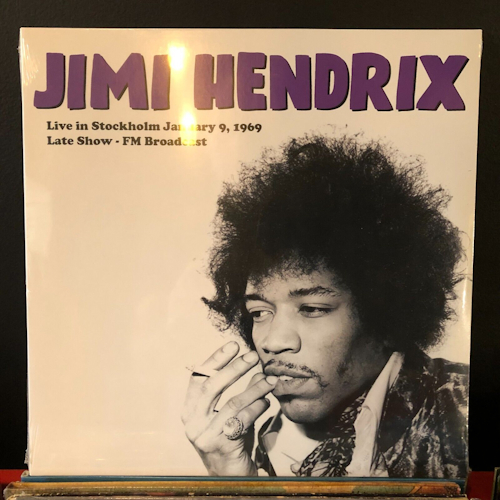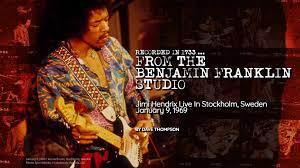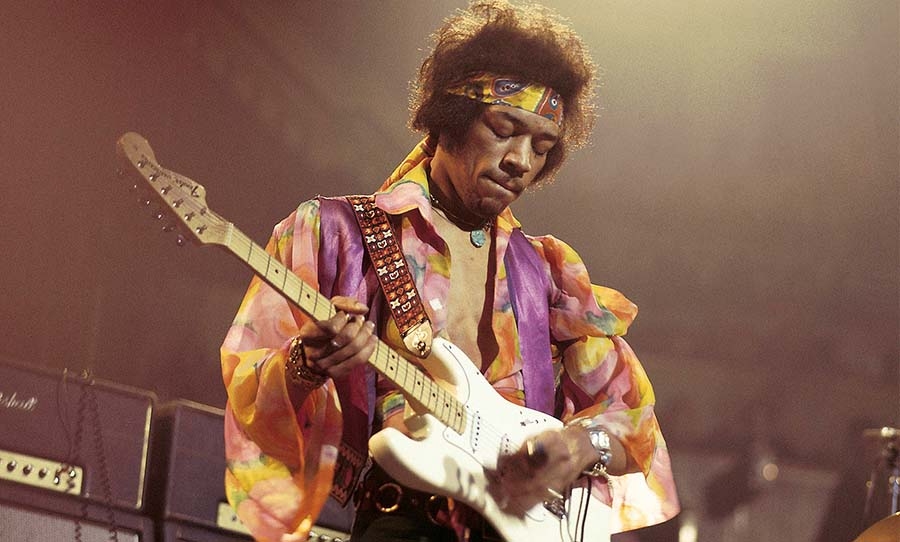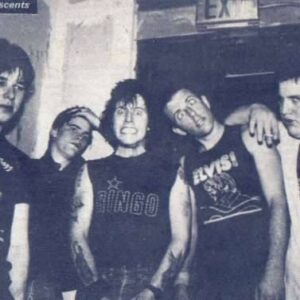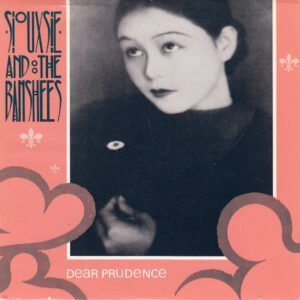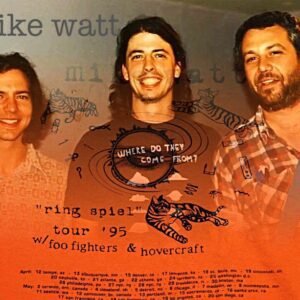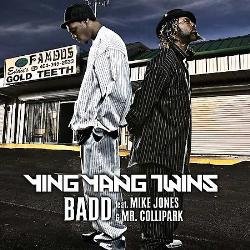Jimi Hendrix – Live in Stockholm (1969)
Description
Jimi Hendrix Live In Stockholm, Sweden
Dec 30 2021
By Dave Thompson.

The holidays were over in every sense of the word, not that Hendrix’s schedule ever lightened up for long. The Experience were due to begin their next European tour in Gothenburg on January 8, 1969, and they didn’t even have time to apply for their visas until the day before they were scheduled to leave.
Of course, some people were convinced The Experience left everything until the last minute, because the band’s own existence was so precarious, that it was pointless trying to plan for the future. The British press in particular; was obsessed with the possibility of The Experience breaking up: Disc & Music Echo habitually referred to Noel Redding as “ex-Hendrix Experience”; both the New Musical Express and Melody Maker chased the rumors through their pages every week; and Noel, for his part, made no secret of the fact that he’d already formed his own new band, Fat Mattress.
Only the band members knew precisely how tenuous their internal bond had become in the last few months, and only manager Mike Jeffrey knew precisely what legal safeguards and contractual pitfalls were in place to keep the band from imploding on the spot. The longest rod he had for their backs was the road, an eternity of gigging that now stretched through to the summer.

In business terms, of course, it was the best thing Jeffrey could do. Any dissent from the band members, any attempt to walk away with bookings yet to be fulfilled, could result in a legal storm of Biblical proportions. Creatively, the maneuver was madness, stifling the band to the point of stagnation. As The Experience prepared to take the stage for the first time in 1969 at the Lorensburg Cirkus in Gothenburg, it was in the knowledge that the only “new number in their entire set was simply a hurriedly rearranged version of “Hear My Train A Comin’.” Everything else had been on autopilot for longer than anyone cared to remember.
The Experience’s disaffection shone through in other ways, too. Producer Chas Chandler later ruminated that the group had physically ceased to function as a group onstage. It was three soloists now, each playing whatever came to mind in a desperate bid to keep his own interest alive. “You could just see there was trouble in the band. There was friction, it wasn’t together, it just didn’t work.” Backstage at the Cirkus, when Hendrix asked Chandler to take over The Experience’s management, the answer was a resounding “no.” Only a madman would want to try looking after a band that close to disintegration.
On January 9, the day after the Gothenburg show, The Experience made the short hop to Stockholm, where they were scheduled to play that same evening. They landed at 2:25, then headed straight into town to the Hotel Carlton.
Even before the concert, they had a full schedule. Journalist Ulla Lundstrom would be waiting to interview Hendrix in his hotel room, almost as soon as the band checked in. Ninety minutes later, all three musicians were scheduled to attend a press reception. Then, there’d just be time to grab some food before they motored down to the Stockholm concert hall – Konserthuset – for the first of the evening’s two shows.

Eire Apparent supported the bulk of the European shows by The Experience. However, Stockholm, and the following night in Copenhagen, Denmark, would offer up some far more esoteric fare: Jethro Tull.
Few people listening to Jethro Tull today, or at any other time in the 50 years since their landmark Aqualung album, would be prepared for the sight and sound of this band. Just one year into their recording career and little more than three months after the release of their first album, Jethro Tull was a wildly improvisational blues band—12-bar progressive rockers with a sound that was discomforting to even contemplate. But they were also reeling from the recent departure of stylish guitarist Mick Abrahams, whose fluid vision the entire group revolved around.
Faced with a string of looming prestige-packed gigs (of which the Hendrix shows were only the tip), Tull scooped the unknown Tony lommi out of a Birmingham club band called Earth, just in time for their appearance on the Rolling Stones’ Rock ‘N’ Roll Circus. lommi really didn’t work out, though. Tull’s call came just as his own band was preparing to change its name to Black Sabbath, and the cast iron riffs he was beginning to trademark had no business interplaying with Tull’s piercing flutes and abrupt signature changes.

The Nice’s Davey O’List very briefly followed lommi before a young, nervous, Martin Barre turned up to audition, so anxious to impress that he forgot to bring his guitar lead. Tull vocalist Ian Anderson reckons he spent the entire audition with his ear pressed up against Barre’s guitar and never did figure out if he was any good or not. But there wasn’t time to try and find some-one else – the guitarist who might not actually have been able to play was going to make his big public debut sharing the stage with a man who could play guitar in his sleep.
Following a short performance by a local band, The Outsiders, Tull’s opening set was designed around Barre’s nerves and inexperience – a stage of mind only exacerbated by local radio’s decision to record the entire show for broadcast a few days earlier. Opening with “My Sunday Feeling,” from Tull’s debut album, the band then threw Barre straight into the limelight by premiering his gentle “Martin’s Tune,” “To Be Sad Is A Mad Way To Be,” “Back To The Family, “Dharma For One,” and “Song For Jeffery” followed, but the highlight of the set – possibly a highlight of Tull’s entire existence – was a 14-minute version of “Nothing Is Easy,” with Anderson wailing away on harmonica and the entire band exploding like a firework party.
The Swedes went crazy and kept the fever pitch blazing through the changeover period. By the time the evening’s emcee was back onstage, he could scarcely be heard above the noise: “Now for a little bit of Electric Church Music. Yeah, that’s how the band likes to call their music. And the band, The Jimi Hendrix Experience.”
“We’re gonna play nothin’ but oldies but baddies tonight.”
~ Jimi Hendrix
The band should have kicked into gear straight away, the music melding with the audience’s applause. Instead, Hendrix ambled to the microphone and said “How y’all doing? I’d like to dedicate this show to the American Deserters Society.”

Photo: Bjorn Alnebo / © Authentic Hendrix, LLC
Sweden, historically neutral through even European wars, was a favorite destination for American draft dodgers. Then he improvised a touch of “Taps,” before returning to the microphone. “We’re gonna play nothin’ but oldies but baddies tonight,” Hendrix continued apologetically, “we haven’t played together in about six weeks, so we’re gonna jam tonight … see what happens. Hope you don’t mind. Just gonna mess around and see what happens.” Then his contempt for the blind applause and devotion, which attended even his most out-of-form performances, burst through as he added (off-mike but still quite audibly) “you wouldn’t know the difference, anyway.”
At last the band started, playing a messy “Killing Floor,” which wandered around a few half-spoken lyrics and incorporated an awful lot of fiddling with amplifiers. Hendrix sounded almost relieved when it finished, only to be plunged back into his private pain when it came time to start the next song. “Like to do a thing that was recorded in 1733 in the Benjamin Franklin Studio, a thing called ‘Spanish Castle Magic.’“ He shrugged disinterestedly into the opening bars and the band picked itself up behind them.
“Like to do a thing that was recorded in 1733 in the Benjamin Franklin Studio, a thing called ‘Spanish Castle Magic.’“
~ Jimi Hendrix
“Fire” flickered gently, but was more akin to warm ashes. The show was almost halfway over and it still hadn’t really got going. “Hey Joe” began in the wrong key, only slowly wound its way back again, then gave way to another admission of Hendrix’s boiling frustration.
Audience calls for “Wild Thing,” a curse since the 1968 release of the Monterey Pop movie, were all but ignored. But one voice in the Konserthuset was pressing a demand that was almost painful to contemplate. “We had a request to do a thing called ‘All Along The Watchtower,’“ Hendrix told the crowd. “But I forgot the words, so we won’t do that one. We’ve never played that before in concert, we only recorded it. I really am sorry.”
Just weeks before, The Experience’s masterful cover of the Bob Dylan classic had given the group one of its biggest hits, but they still hadn’t learned how to play it live. If any single situation summed up the sheer hell that the three musicians were living through, this was it.
Instead, Hendrix announced “Voodoo Child,” the solitary number from Electric Ladyland they had managed to absorb into their live show, then appeared to have forgotten how that one went as well. Noel came to his rescue: “It goes like this, Jimi, remember,” then “nah nah nah”-ed the opening wah wah line. Hendrix echoed him on the guitar, but halfway through the song, which itself had already degenerated into a very loose jam, he appeared to have lost interest again – so much so that first Mitch, then Noel, suddenly found themselves filling the empty space with impromptu solos.
Hendrix snapped back to alertness for a lengthy “Red House,” the best number of the show so far, but he drifted off again in the closing song, leaving Noel to solo through a version of “Sunshine Of Your Love,” which stumbled off-stage with the musicians and left the crowd wondering just what had gone wrong.

Photo: Bjorn Alnebo / © Authentic Hendrix, LLC
Backstage, The Experience was asking the same question. They were locked into earnest postmortem through another dynamite blast from Jethro Tull, but from the moment they hit the stage for their own show, the difference between the two performances was gargantuan. Whatever was said in the dressing room had worked.
There was no long preamble before the first song, no disconsolate messing around with machine heads and volume settings. Instead, Hendrix just nodded and Mitchell launched the pounding Cherokee beat that heralded “I Don’t Live Today.”
“Spanish Castle Magic” followed, living up to Hendrix’s smiled caution as the song got underway: “I’d like to warn you now, it’s gonna be a bit loud. A tiny bit loud because these are English amps and we’re in Sweden, and the electricity scene is not working out with this Australian fuzztone and this American guitar.”
Up next was “Hey Joe,” on key this time, and provided an excuse for Hendrix to make up new lyrics and improvise some old ones. He threw in a snatch of “Day Tripper,” and when Noel suggested they follow it with “Johnny B. Goode,” Hendrix’s laugh proved he was tempted.
“I’d like to dedicate this song to all those people who can actually feel and think for themselves and feel free for themselves.”
~ Jimi Hendrix
Instead, he went into his longest spiel of the show, another condemnation of the inhumane schedule the band was laboring beneath, but a smiling one: “We got this LP out called Electric Ladyland and there’s only one song that we remember from it, because, I dunno, it’s like a diary all these LPs. That’s why we don’t necessarily do them onstage all the time. We just like to jam onstage.” Then he threw the figurative book at Mike Jeffrey: “I’d like to dedicate this song to all those people who can actually feel and think for themselves and feel free for themselves.” Luxuries, of course, which The Experience’s schedule all but forbade them from enjoying.
“Voodoo Child (Slight Return)” was a revelation, not only for its revealing preamble, but also for the country blues solo Hendrix dropped into the middle, while Noel and Mitch simply stood and watched.
Then it was back to basics with “Sunshine Of Your Love,” “Red House,” “Fire,” “Purple Haze,” and wrapping the night up on an even more unexpected high with “Star Spangled Banner,” a feedback-drenched slab of patriotic irony that brought the Konserthuset performances full circle, back to Hendrix’s dedication to the American Deserter’s Society at the start of the first set.
The roars from the audience proved that the “Society” appreciated the gesture.

“NUMBER NINE” STOCKHOLM, SWEDEN BROADCAST
In 2001, previously unreleased live performance footage from The Jimi Hendrix Experience’s concert at Konserthuset in Stockholm, Sweden was released as a bonus program on the DVD release of Experience: Jimi Hendrix. Featuring Hendrix’s blues masterwork “Red House as well as a high velocity rendition of Cream’s “Sunshine Of Your Love,” this rare footage, recorded for Number Nine—the SVT Swedish Television program—featured Hendrix performing with a Gibson SG rather than his more familiar Fender Stratocaster. While this release is now out of production; interested fans may wish to seek this program on DVD (or VHS tape for those inclined) via used music retailers and collector-to-collector marketplaces.
# # #


